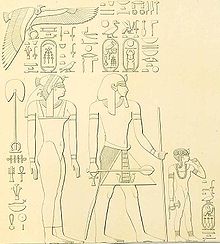Ahmose (King Wife)
| Ahmose (King Wife) in hieroglyphics | |||||||||||||
|---|---|---|---|---|---|---|---|---|---|---|---|---|---|
| 18th dynasty |
Jˁḥ ms The moon is born |
||||||||||||
Ahmose , also Ahmes , was an ancient Egyptian queen of the 18th Dynasty ( New Kingdom ) and great royal consort of Thutmose I. Her other titles include the king's mother and sister of the king .
Origin and family
The parents of Queen Ahmose have so far not been archaeologically proven by inscriptions. So there are different views on their origin in Egyptology. Aidan Dodson describes their family relationships as uncertain, as it is not clear to which person the title royal sister actually refers. Your spouse or one of his predecessors can be considered. She never bears the title of king's daughter , which would be assumed if she were the daughter of a predecessor of her husband, a king. The latter title, however, is documented for the second wife of Thutmose I, Mutnofret .
According to Thomas Schneider , Ahmose was the daughter of Amenophis I. Since the paternal line for Thutmose I is not documented, he could only come to the throne by marrying Ahmose.
Hermann A. Schlögl, on the other hand, sees Ahmose as the daughter of King Ahmose I , the founder of the 18th dynasty, and Queen Ahmose Nefertari , the only living consort of Amun at that time .
It is generally believed that Ahmose and Thutmose I. had four children. However, only the princesses Hatshepsut and Nofrubiti are certain. The two sons are Amunmose and Wadjmes .
supporting documents
Queen Ahmose is shown on a group of statues together with Thutmose I and the god Amun .
Her daughter Hatshepsut shows and names her on reliefs of her birth legend in the mortuary temple in Deir el-Bahari . Another example is a statue of the priest of the dead from Karnak .
Queen Ahmose also appears on a memorial stone of Thutmose II. This memorial stone (ÄGM 15699) is, however, a proven forgery from the presumably late 19th century, in all likelihood made to serve as a "piece of evidence" of the scientific dispute of the time about the exact family relationships between Queen Hatshepsut and Thutmose II (spouse or not) to give a desired direction.
The posthumous veneration of Ahmose goes back to the Ramesside period , where it is attested on grave reliefs.
She is mentioned on the stele of Juef from Edfu , who served under her and whom she promoted to scribe for the seal of God .
literature
- Aidan Dodson , Dyan Hilton: The Complete Royal Families of Ancient Egypt. Thames & Hudson, London 2004, ISBN 0-500-05128-3 , pp. 130, 137.
- Wilfried Seipel : Ahmose. In: Wolfgang Helck (Hrsg.): Lexikon der Ägyptologie (LÄ). Volume I, Harrassowitz, Wiesbaden 1975, ISBN 3-447-01670-1 , Sp. 101-102.
- Joyce Tyldesley : The Queens of Ancient Egypt. From the early dynasties to the death of Cleopatra. Koehler & Amelang, Leipzig 2008, ISBN 978-3-7338-0358-2 , p. 92.
Individual evidence
- ^ Thomas Schneider : Lexicon of the Pharaohs. Albatros, Düsseldorf 2002, ISBN 3-491-96053-3 , p. 289.
- ^ Hermann A. Schlögl : The old Egypt. History and culture from the early days to Cleopatra. Beck, Munich 2006, ISBN 3-406-54988-8 , p. 194.
- ↑ Inventory number: Kairo CG 42052.
- ↑ Inventory number: Berlin 15699; Kurt Sethe : Documents of the 18th Dynasty. Volume 1, Hinrichs, Leipzig 1906, pp. 143f.
- ^ Yearbook of Prussian Cultural Heritage. XXXV.1998, p. 203ff., Chr. Goedicke and R.Krauss: Der Denkstein Berlin ÄGM 15699 - a fake Egyptologist
- ↑ Wilfried Seipel: Lexicon of Egyptology. (LÄ) Volume I, Wiesbaden 1975, column 101.
- ↑ James Henry Breasted : Ancient Records of Egypt. Vol II , Chicago 1906, pp. 46 109-114
| personal data | |
|---|---|
| SURNAME | Ahmose |
| BRIEF DESCRIPTION | ancient egyptian queen |
| DATE OF BIRTH | 16th century BC Chr. |
| DATE OF DEATH | 16th century BC Chr. |
